Developing Broadband Microstrip Patch Antennas Fed by SIW Feeding Network for Spatially Low Cross-Polarization Situation
Abstract
:1. Introduction
2. Structure Topology
2.1. Subsection
2.2. Feed Network Topology
3. Discussion of Experimental Result
3.1. Array Fabrication
3.2. Radiation Characteristic of the Proposed Structure
3.3. Antenna’s Efficiency
3.4. State of the Art Aspects
4. Conclusions
Author Contributions
Funding
Institutional Review Board Statement
Informed Consent Statement
Data Availability Statement
Acknowledgments
Conflicts of Interest
References
- Illahi, U.; Iqbal, J.; Sulaiman, M.I.; Alam, M.; Su’ud, M.M.; Khattak, M.I. Design and development of a singly-fed circularly polarized rectangular dielectric resonator antenna for WiMAX/Satellite/5G NR band applications. AEU-Int. J. Electron. Commun. 2020, 126, 153443. [Google Scholar] [CrossRef]
- Li, Y.; Luk, K.M. 60-GHz Substrate integrated waveguide fed cavity-backed aperture-coupled microstrip patch antenna arrays. IEEE Trans. Antennas Propag. 2015, 63, 1075–1085. [Google Scholar] [CrossRef]
- Karami, F.; Amn-e-Elahi, A.; Meiguni, J.S.; Rezaei, P.; Denidni, T.A.; Kishk, A.A. Monopulse antenna array based on three-modes with orthogonal radiation beams. AEU-Int. J. Electron. Commun. 2021, 142, 154015. [Google Scholar] [CrossRef]
- Liu, H.; Qing, A.; Xu, Z.; Yu, Z.; Zhang, S. Design of Physically Connected Wideband SIW Cavity-Backed Patch Antenna for Wide-Angle Scanning Phased Arrays. IEEE Antennas Wirel. Propag. Lett. 2021, 20, 406–410. [Google Scholar] [CrossRef]
- Zarbakhsh, S.; Akbari, M.; Farahani, M.; Ghayekhloo, A.; Denidni, T.A.; Sebak, A.-R. Optically Transparent Subarray Antenna Based on Solar Panel for CubeSat Application. IEEE Trans. Antennas Propag. 2019, 68, 319–328. [Google Scholar] [CrossRef]
- Kim, G.; Kim, S. Design and analysis of dual polarized broadband microstrip patch antenna for 5G mmwave antenna module on FR4 substrate. IEEE Access 2021, 9, 64306–64316. [Google Scholar] [CrossRef]
- Balanis, C.A. Antenna Theory: Analysis and Design; John Wiley & Sons: Hoboken, NJ, USA, 2016. [Google Scholar]
- Karami, F.; Rezaei, P.; Amn-e-Elahi, A.; Sharifi, M.; Meiguni, J.S. Efficient Transition Hybrid Two-Layer Feed Network: Polarization Diversity in a Satellite Transceiver Array Antenna. IEEE Antennas Propag. Mag. 2019, 63, 51–60. [Google Scholar] [CrossRef]
- Pozar, D.M.; Schaubert, D.H. Microstrip Antennas, the Analysis and Design of Microstrip Antennas and Arrays; IEEE Press: New York, NY, USA, 1995. [Google Scholar]
- Boutayeb, H.; Denidni, T.A. Gain enhancement of a microstrip patch antenna using a cylindrical electromagnetic crystal substrate. IEEE Trans. Antennas Propag. 2007, 55, 3140–3145. [Google Scholar] [CrossRef] [Green Version]
- Tong, K.F.; Luk, K.M.; Lee, K.F.; Lee, R.Q. A broad-band U-slot rectangular patch antenna on a microwave substrate. IEEE Trans. Antennas Propag. 2000, 48, 954–960. [Google Scholar] [CrossRef]
- Fallah, M.; Ghayekhloo, A.; Abdolali, A. Design of frequency selective band stop shield using analytical method. J. Microw. Optoelectron. Electromagn. Appl. 2015, 14, 217–228. [Google Scholar] [CrossRef] [Green Version]
- Ghayekhloo, A.; Abdolali, A.; Armaki, S.H. Observation of radar cross-section reduction using low-pressure plasma-arrayed coating structure. IEEE Trans. Antennas Propag. 2017, 65, 3058–3064. [Google Scholar] [CrossRef]
- Akbari, M.; Farahani, M.; Ghayekhloo, A.; Zarbakhsh, S.; Sebak, A.-R.; Denidni, T.A. Beam Tilting Approaches Based on Phase Gradient Surface for mmWave Antennas. IEEE Trans. Antennas Propag. 2020, 68, 4372–4385. [Google Scholar] [CrossRef]
- Cai, S.; Liu, J.; Long, Y. Investigation of SIW cavity-backed slot and patch antennas with conical radiation patterns. IEEE Trans. Antennas Propag. 2020, 68, 5978–5988. [Google Scholar] [CrossRef]
- Ghayekhloo, A.; Afsahi, M.; Orouji, A.A.; Denidni, T.A. Triangle and Aperiodic Metasurfaces for Bistatic Backscattering Engineering. Phys. Status Solidi B 2019, 256, 1900059. [Google Scholar] [CrossRef]
- Nedil, M.; Habib, M.A.; Denidni, T.A.; Boutayeb, H. Quasi-metallic-wall technique for increasing the efficiency of CB-CPW antennas. Prog. Electromagn. Res. 2008, 78, 437–455. [Google Scholar] [CrossRef] [Green Version]
- Karami, F.; Rezaei, P.; Amn-e-Elahi, A.; Meiguni, J.S. A compact and wideband array antenna with efficient hybrid feed network. Int. J. RF Microw. Comput.-Aided Eng. 2020, 30, e22393. [Google Scholar] [CrossRef]
- Yang, T.Y.; Hong, W.; Zhang, Y. Wideband millimeter-wave substrate integrated waveguide cavity-backed rectangular patch antenna. IEEE Antennas Wirel. Propag. Lett. 2014, 13, 205–208. [Google Scholar] [CrossRef]
- Ghayekhloo, A.; Abdolali, A. Use of collisional plasma as an optimum lossy dielectric for wave absorption in planar layers, analysis, and application. IEEE Trans. Plasma Sci. 2014, 42, 1999–2006. [Google Scholar] [CrossRef]
- Zhou, H.; Hong, W.; Tian, L.; Cheng, L. Cross-polarization suppressed and linearly polarized patch array antenna with cavity-backed slot feed for vehicle applications. IEEE Antennas Wirel. Propag. Lett. 2016, 15, 126–129. [Google Scholar] [CrossRef]
- Ghayekhloo, A.; Afsahi, M.; Orouji, A.A. An optimized checkerboard structure for cross-section reduction: Producing a coating surface for bistatic radar using the equivalent electric circuit model. IEEE Antennas Propag. Mag. 2018, 60, 78–85. [Google Scholar] [CrossRef]
- Harrington, R.F. Effect of antenna size on gain, bandwidth, and efficiency. J. Res. Natl. Bur. Stand.-D Radio Propag. 1960, 64D, 1. [Google Scholar] [CrossRef]
- Ghayekhloo, A.; Akbari, M.; Afsahi, M.; Orouji, A.A.; Sebak, A.R.; Denidni, T.A. Multifunctional Transparent Electromagnetic Surface Based on Solar Cell for Backscattering Reduction. IEEE Trans. Antennas Propag. 2019, 67, 4302–4306. [Google Scholar] [CrossRef]
- Hansen, R.C. Fundamental limitations in antennas. Proc. IEEE 1981, 69, 170–182. [Google Scholar] [CrossRef]
- Geyi, W. Physical limitations of antenna. IEEE Trans. Antennas Propag. 2003, 51, 2116–2123. [Google Scholar] [CrossRef] [Green Version]
- Shahpari, M.; Thiel, D.V. Fundamental limitations for antenna radiation efficiency. IEEE Trans. Antennas Propag. 2018, 66, 3894–3901. [Google Scholar] [CrossRef] [Green Version]
- Diman, A.A.; Karami, F.; Rezaei, P.; Amn-e-Elahi, A.; Mousavirazi, Z.; Denidni, T.A.; Kishk, A.A. Efficient SIW-feed network suppressing mutual coupling of slot antenna array. IEEE Trans. Antennas Propag. 2021, 69, 6058–6063. [Google Scholar] [CrossRef]
- Boutayeb, H. Substrate Integrated Waveguide Switch. US Patent US9985331B2, 29 May 2018. [Google Scholar]
- Hautcoeur, J.; Hettak, K.; Talbi, L.; Nedil, M.; Shaker, J.; Wu, K. A novel two-layer low-profile 23-GHz microstrip array fed by slots in an SIW for wireless backhauling applications. IEEE Trans. Compon. Packag. Manuf. Technol. 2017, 7, 1126–1135. [Google Scholar] [CrossRef]
- Yang, Q.; Gao, S.; Luo, Q.; Wen, L.; Ban, Y.-L.; Yang, X.-X.; Ren, X.; Wu, J. Cavity-Backed Slot-Coupled Patch Antenna Array With Dual Slant Polarization for Millimeter-Wave Base Station Applications. IEEE Trans. Antennas Propag. 2020, 69, 1404–1413. [Google Scholar] [CrossRef]
- Amn-e-Elahi, A.; Rezaei, P. SIW corporate-feed network for circular polarization slot array antenna. Wirel. Pers. Commun. 2020, 111, 2129–2136. [Google Scholar] [CrossRef]
- Yusuf, Y.; Cheng, H.; Gong, X. Co-designed substrate-integrated waveguide filters with patch antennas. IET Microw. Antennas Propagat 2013, 7, 493–501. [Google Scholar] [CrossRef]
- Li, T.; Gong, X. Vertical integration of high-Q filter with circularly polarized patch antenna with enhanced impedance-axial ratio bandwidth. IEEE Trans. Microw. Theory Technol. 2018, 66, 3119–3128. [Google Scholar] [CrossRef]
- Mikulasek, T.; Lacik, J. Two feeding methods based on substrate integrated waveguide for microstrip patch antennas. IET Microw. Antennas Propagat 2015, 9, 423–430. [Google Scholar] [CrossRef]
- Karami, F.; Rezaei, P.; Amn-e-Elahi, A.; Abolfathi, A.; Kishk, A.A. Broadband and efficient patch array antenna fed by substrate integrated waveguide feed network for Ku-band satellite applications. Int. J. RF Microw. Comput. Eng. 2021, 31, e22772. [Google Scholar] [CrossRef]
- Huynh, T.; Lee, K.F.; Lee, R.Q. Cross-polarization characteristics of rectangular patch antennas. Electron. Lett. 1988, 24, 463–464. [Google Scholar] [CrossRef]
- Mikulasek, T.; Lacik, J.; Puskely, J.; Raida, Z. Design of aperture-coupled microstrip patch antenna array fed by SIW for 60 GHz band. IET Microw. Antennas Propag. 2016, 10, 288–292. [Google Scholar] [CrossRef]
- Karami, F.; Rezaei, P.; Amn-e-Elahi, A.; Abolfathi, A. An X-Band Substrate Integrated Waveguide Fed Patch Array Antenna: Overcoming low efficiency, narrow impedance bandwidth, and cross-polarization radiation challenges. IEEE Antennas Propag. Mag. 2021, 63, 25–32. [Google Scholar] [CrossRef]
- Teniente, J.; Martinez, A.; Larumbe, B.; Ibanez, A.; Gonzalo, R. Design Guidelines of Horn Antennas That Combine Horizontal and Vertical Corrugations for Satellite Communications. IEEE Trans. Antennas Propag. 2015, 63, 1314–1323. [Google Scholar] [CrossRef]
- Kumar, C.; Guha, D. Defected ground structure (DGS)-integrated rectangular microstrip patch for improved polarisation purity with wide impedance bandwidth. IET Microw. Antennas Propag. 2014, 8, 589–596. [Google Scholar] [CrossRef]
- Woelders, K.; Granholm, J. Cross-polarization and side lobe suppression in dual linear polarization antenna arrays. IEEE Trans. Antennas Propag. 1997, 45, 1727–1740. [Google Scholar] [CrossRef] [Green Version]
- Karami, F.; Rezaei, P.; Amn-e-Elahi, A.; Mousavirazi, Z.; Denidni, T.A.; Kishk, A.A. A compact high-performance patch array with suppressed cross polarization using image feed configuration. AEU-Int. J. Electron. Commun. 2020, 127, 153479. [Google Scholar] [CrossRef]
- IEEE Std 145-2013 (Revision of IEEE Std 145-1993); IEEE Standard for Definitions of Terms for Antennas; IEEE: Piscataway, NJ, USA, 2014; pp. 1–50.
- Liu, B.; Sha, K.; Zhou, M.F.; Song, K.X.; Huang, Y.H.; Hu, C.C. Novel low-εr MGa2O4 (M = Ca, Sr) microwave dielectric ceramics for 5G antenna applications at the sub-6 GHz band. J. Eur. Ceram. Soc. 2021, 41, 5170–5175. [Google Scholar] [CrossRef]
- Bayat-Makou, N.; Kishk, A.A. Substrate integrated horn antenna with uniform aperture distribution. IEEE Trans. Antennas Propag. 2017, 65, 514–520. [Google Scholar] [CrossRef]
- Zhu, Q.; Ng, K.B.; Chan, C.H.; Luk, K.M. Substrate-integrated-waveguide-fed array antenna covering 57–71 GHz band for 5G applications. IEEE Trans. Antennas Propag. 2017, 65, 6298–6306. [Google Scholar] [CrossRef]
- Jin, H.; Chin, K.S.; Che, W.; Chang, C.C.; Li, H.J.; Xue, Q. A broadband patch antenna array with planar differential L-shaped feeding structures. IEEE Antennas Wirel. Propag. Lett. 2014, 14, 127–130. [Google Scholar] [CrossRef]
- Xu, J.; Hong, W.; Jiang, Z.H.; Zhang, H. Wideband, low-profile patch array antenna with corporate stacked microstrip and substrate integrated waveguide feeding structure. IEEE Trans. Antennas Propag. 2019, 67, 1368–1373. [Google Scholar] [CrossRef]
- Wu, P.; Liao, S.; Xue, Q. A substrate integrated slot antenna array using simplified feeding network based on higher order cavity modes. IEEE Trans. Antennas Propag. 2015, 64, 126–135. [Google Scholar] [CrossRef]
- Jin, H.; Che, W.; Chin, K.; Shen, J.; Yang, W.; Xue, Q. 60-GHz LTCC differential-fed patch antenna array with high gain by using soft-surface structures. IEEE Trans. Antennas Propag. 2017, 65, 206–216. [Google Scholar] [CrossRef]
- Lee, J.H.; Kidera, N.; DeJean, G.; Pinel, S.; Laskar, J.; Tentzeris, M.M. A V-band front-end with 3-D integrated cavity filters/duplexers and antenna in LTCC technologies. IEEE Trans. Microw. Theory Technol. 2006, 54, 2925–2936. [Google Scholar]
- Mikulasek, T.; Lacik, J. Microstrip patch antenna fed by substrate integrated waveguide. In Proceedings of the 2011 International Conference on Electromagnetics in Advanced Applications, Turin, Italy, 12–16 September 2011; pp. 1209–1212. [Google Scholar]
- Mikulasek, T.; Georgiadis, A.; Collado, A.; Lacik, J. 2x2 Microstrip patch antenna array fed by substrate integrated waveguide for radar applications. IEEE Antennas Wirel. Propag. Lett. 2013, 12, 1287–1290. [Google Scholar] [CrossRef]
- Meiguni, J.; Haddad, K.; Hosseinbeig, A. Longitudinal slotted waveguide array feed networks. Int. J. Microw. Wirel. Technol. 2018, 10, 512–517. [Google Scholar] [CrossRef]
- Soleiman, J.; Khatami, S.A.; Amn-e-Elahi, A. Compact substrate integrated waveguide mono-pulse antenna array. Int. J. RF Microw. Comp.-Aided Eng. 2018, 28, e21155. [Google Scholar] [CrossRef] [Green Version]
- Akbari Choubar, M. Performance Enhancement of Radiation and Scattering Properties of Circularly Polarized Antennas Using Frequency Selective Surface. Ph.D. Thesis, Concordia University, Montréal, QC, Canada, 2018. [Google Scholar]
- Jin, H.; Chin, K.-S.; Che, W.; Chang, C.-C.; Li, H.-J.; Xue, Q. Differential-Fed Patch Antenna Arrays with Low Cross Polarization and Wide Bandwidths. IEEE Antennas Wirel. Propag. Lett. 2014, 13, 1069–1072. [Google Scholar] [CrossRef]
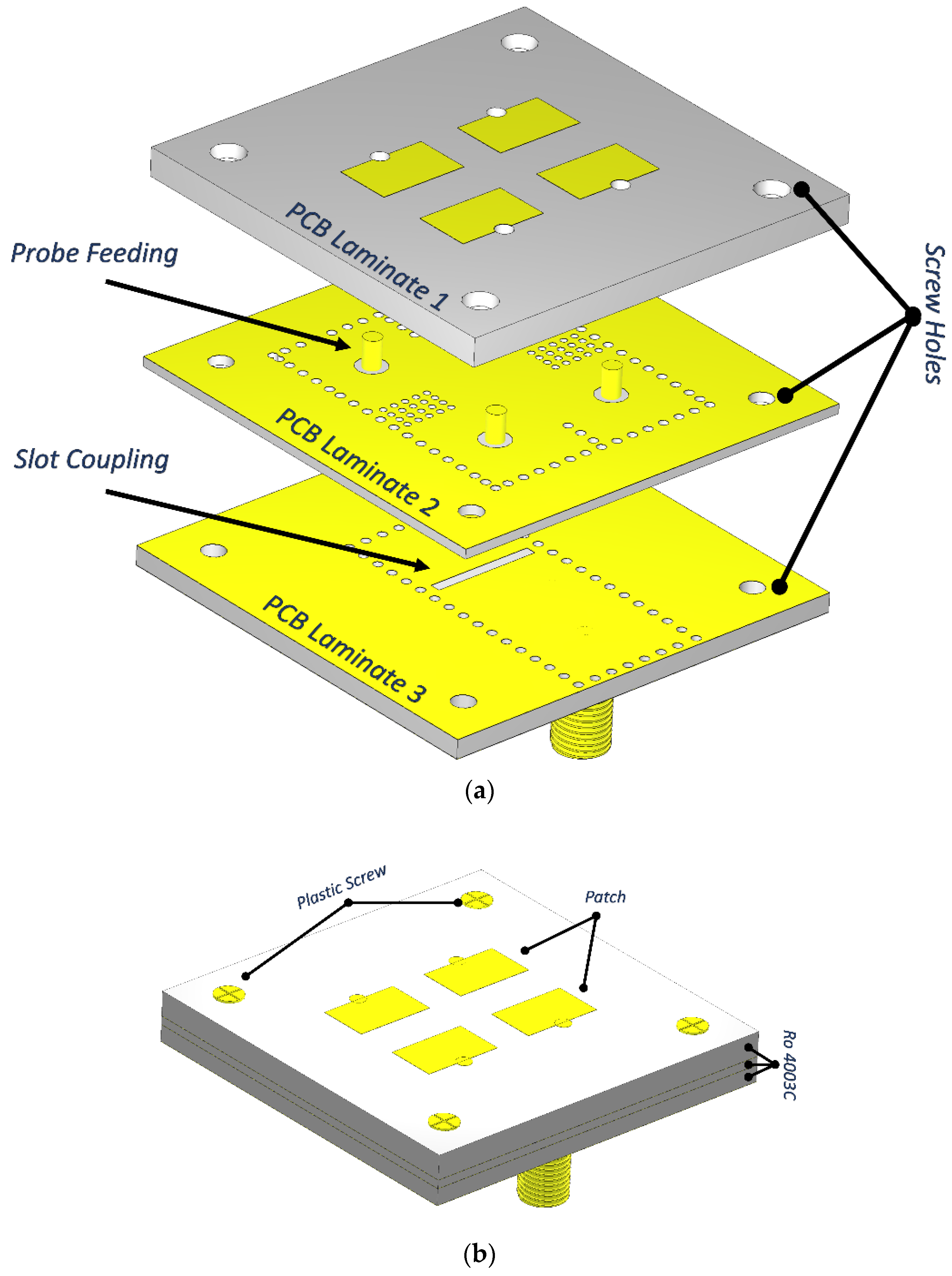
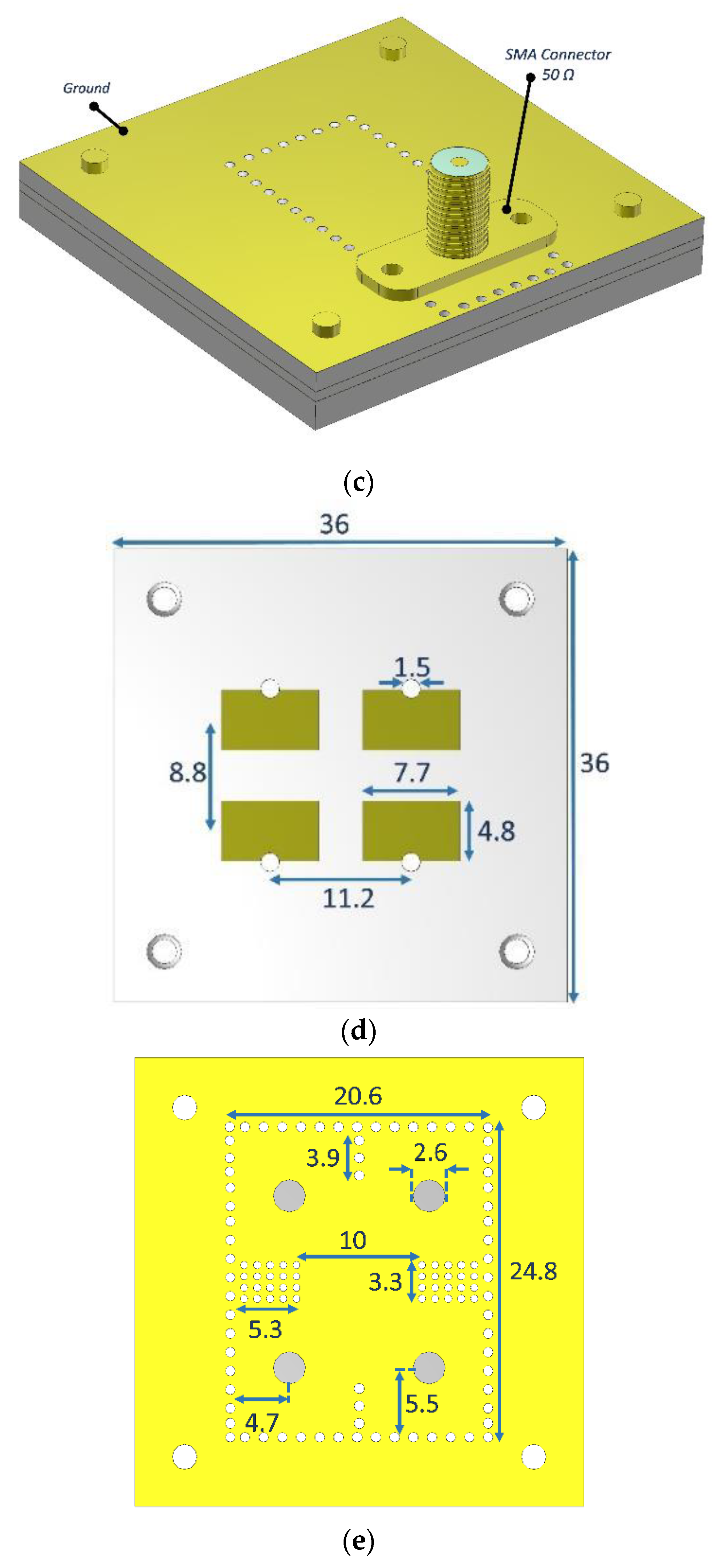
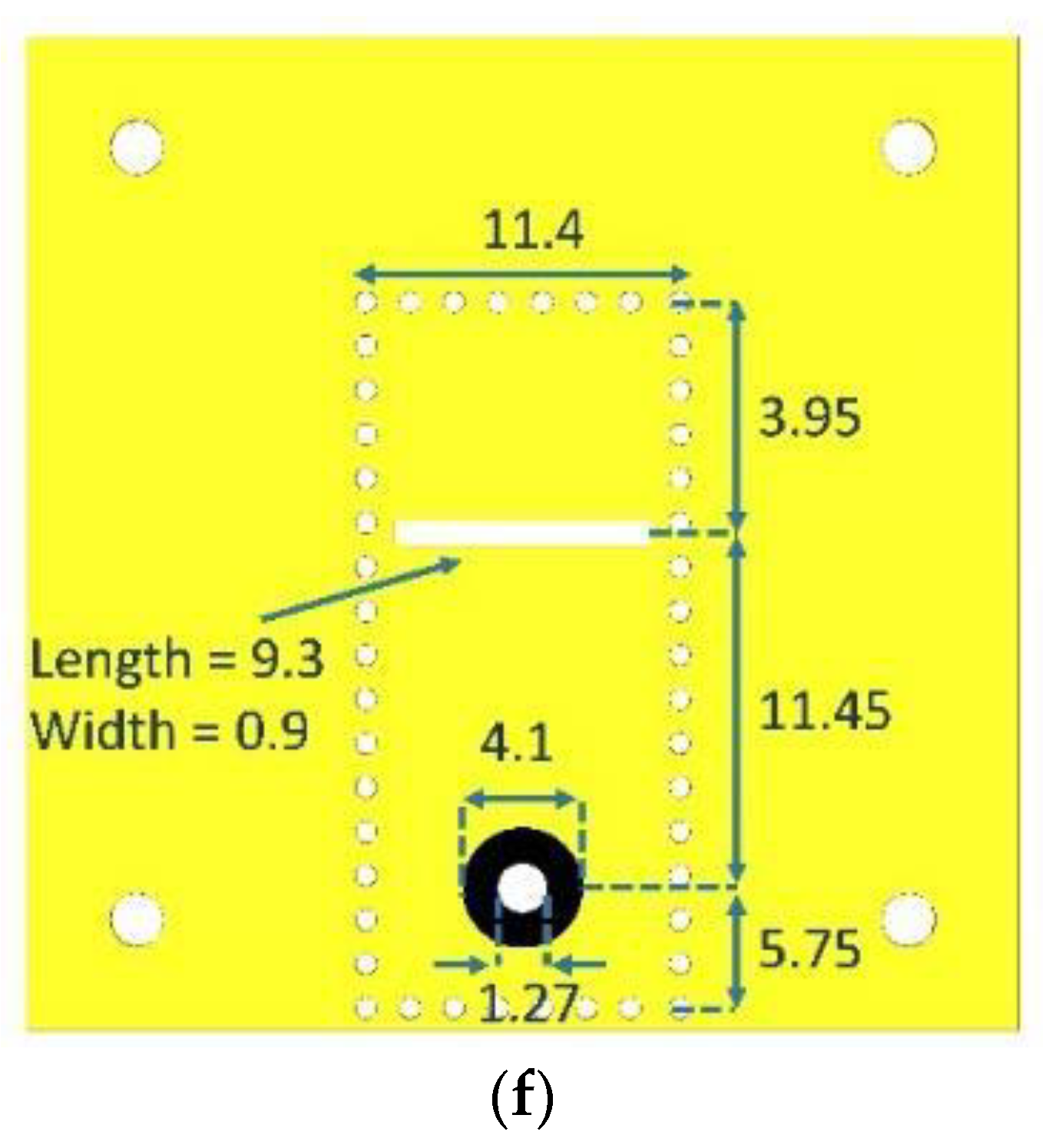

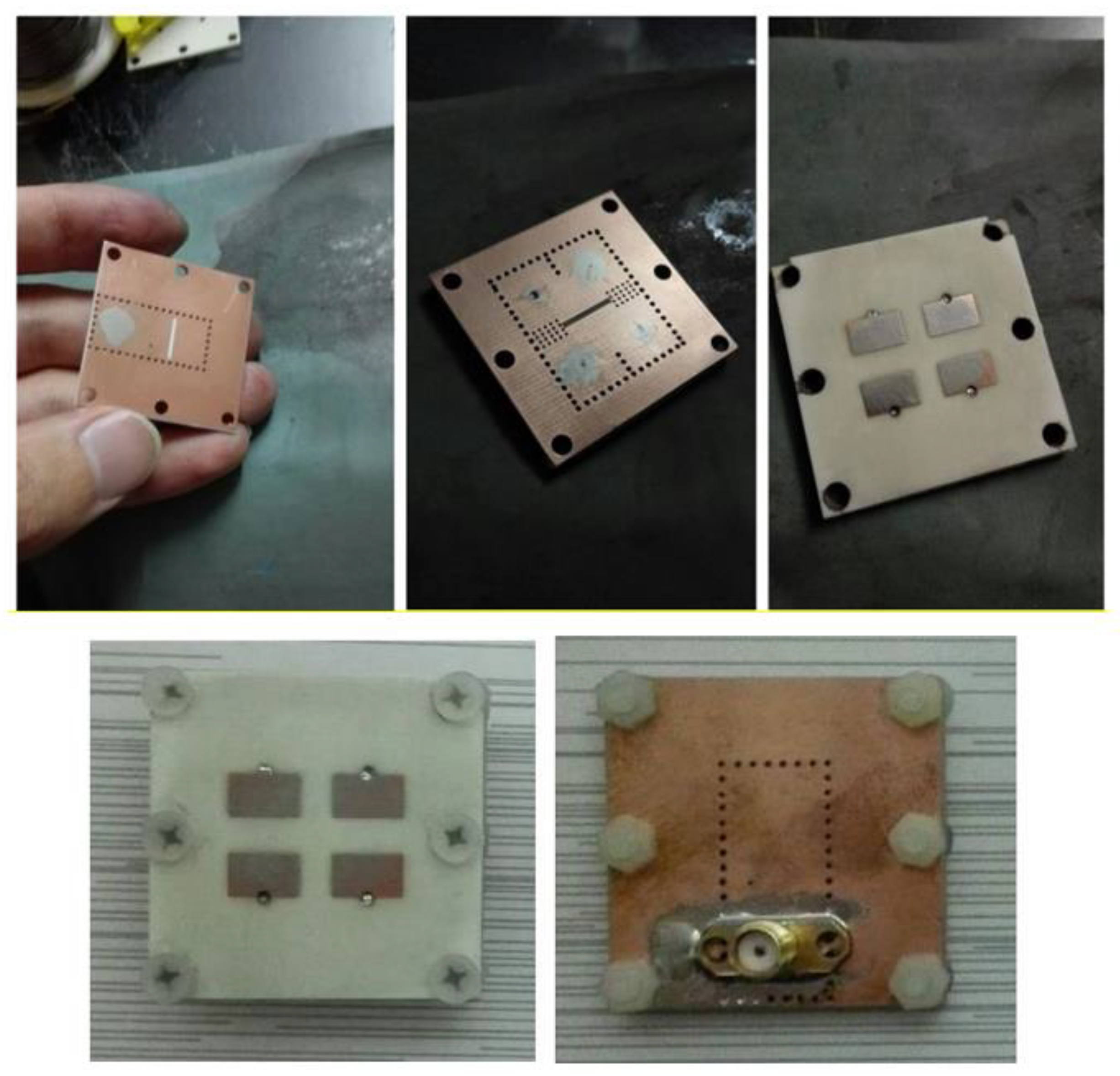
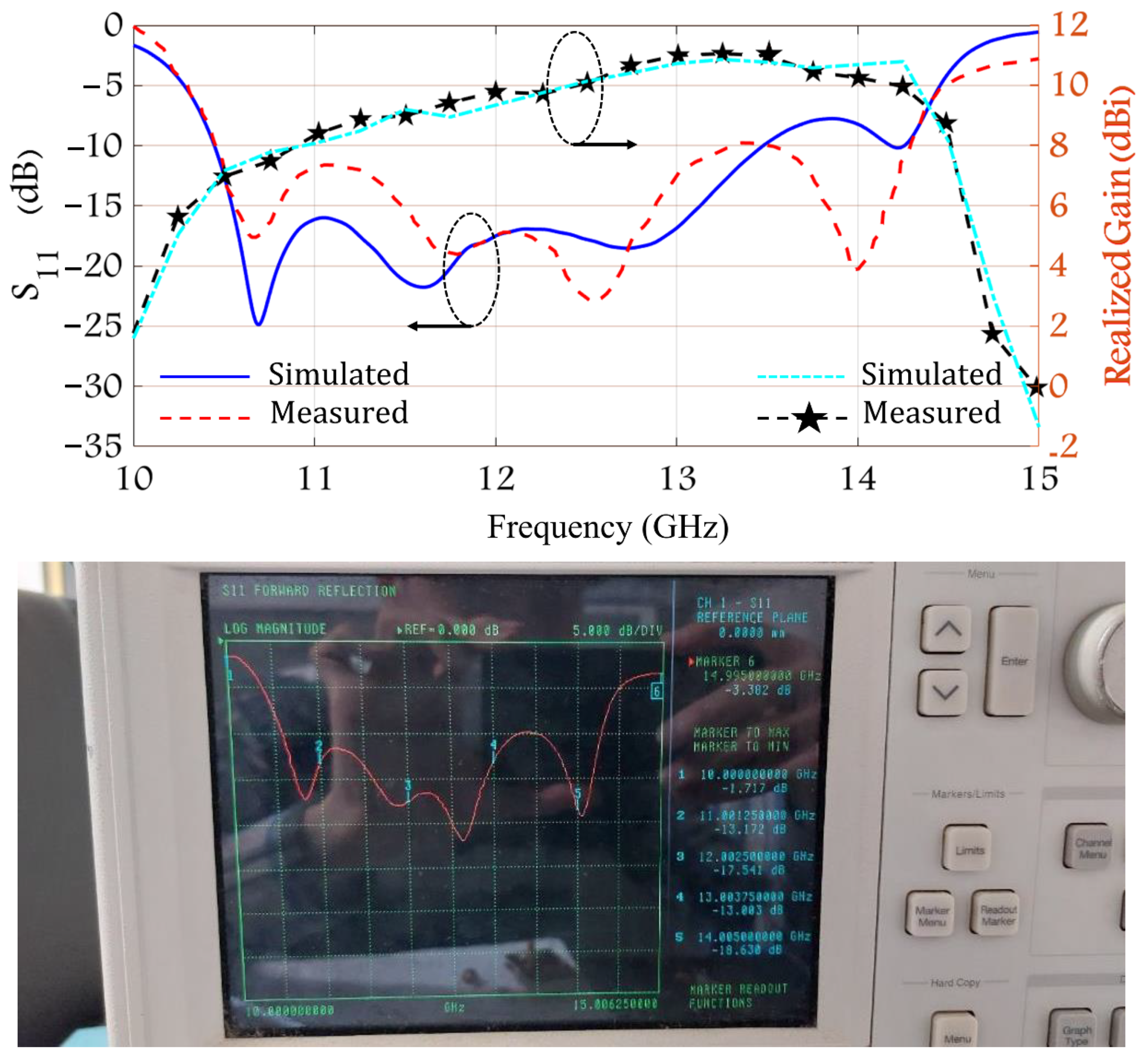
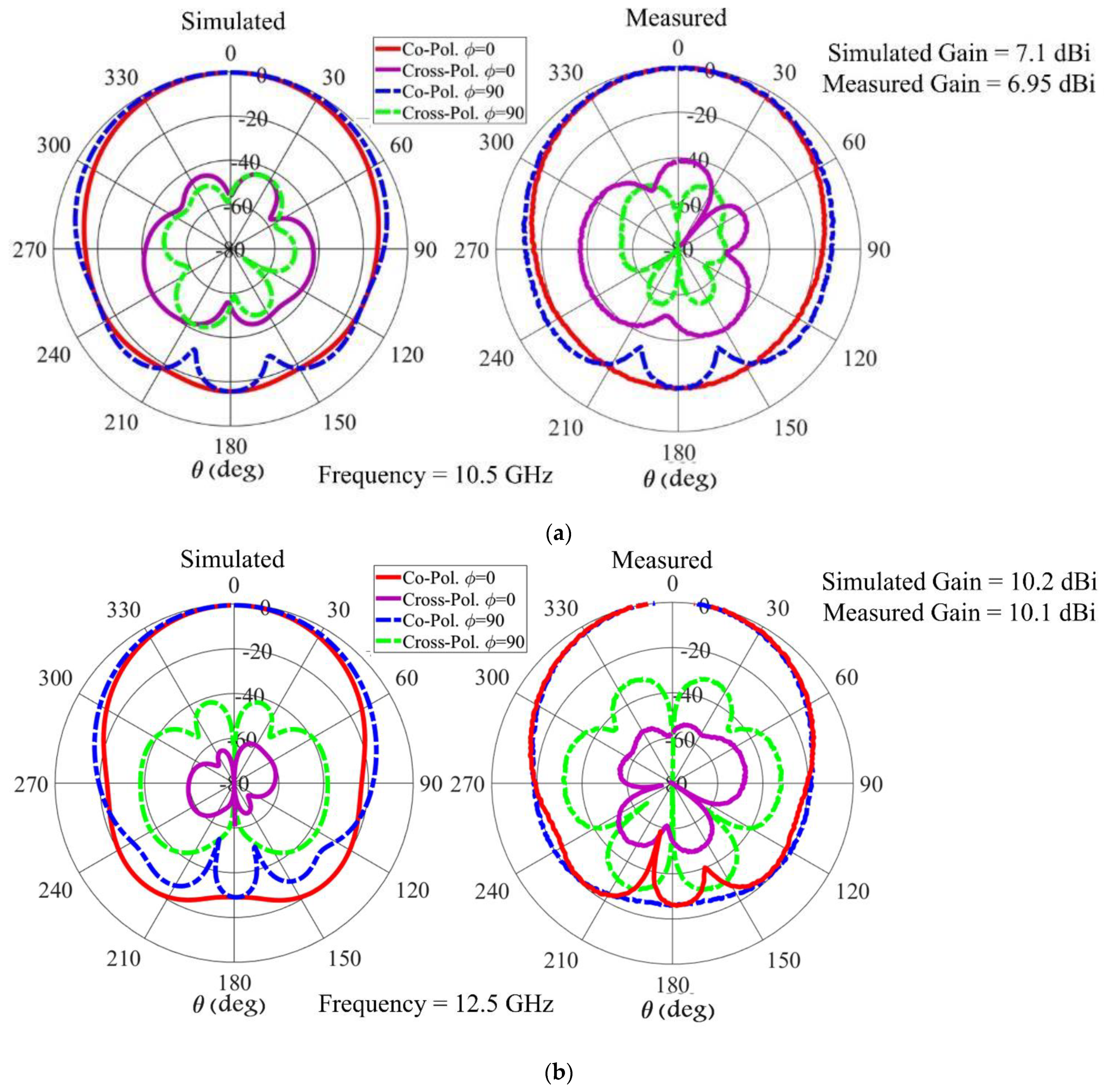
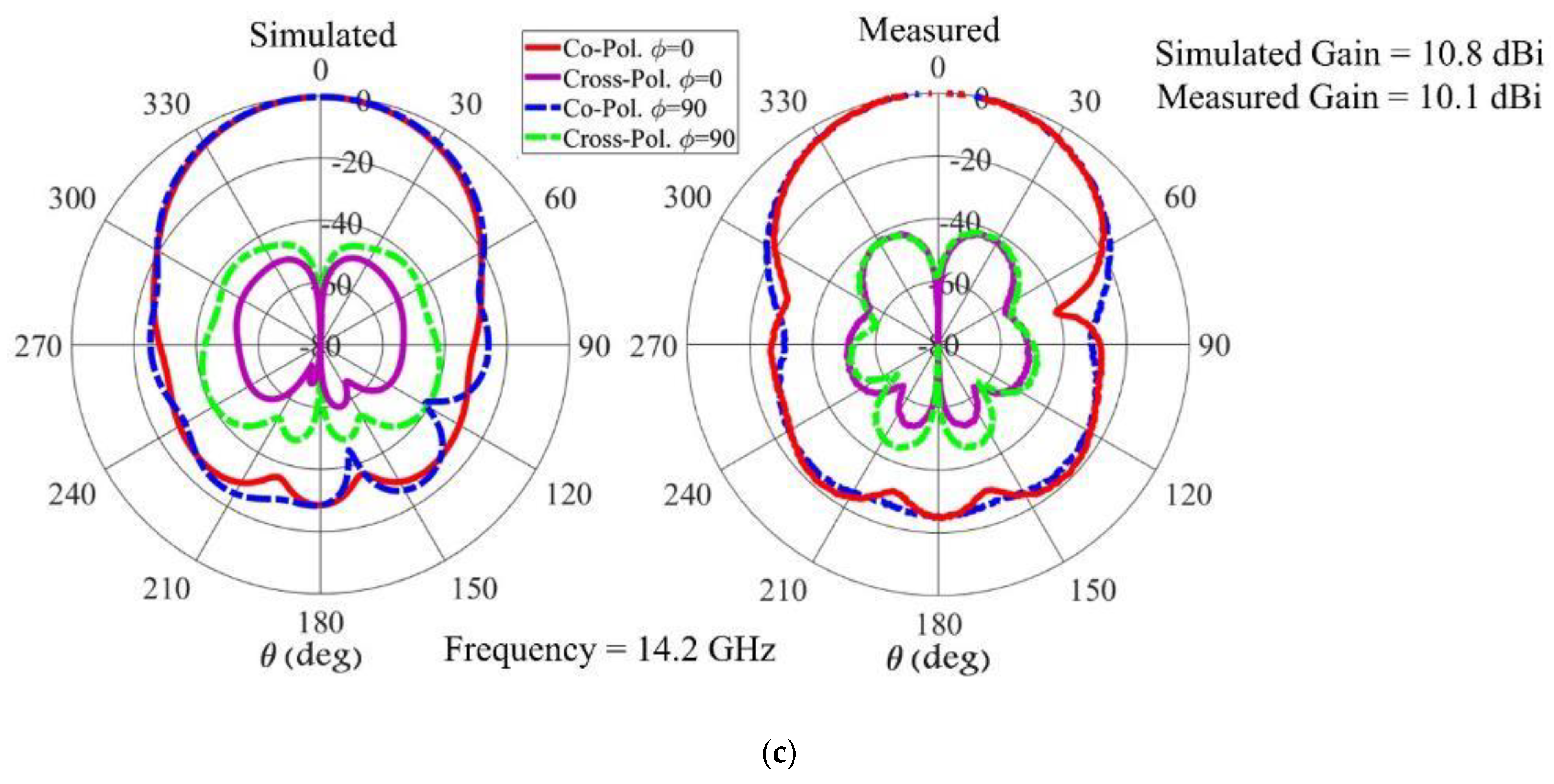

| Ref. | Number of Layers | Number of Ports | Aperture Size () | Max Gain (dB) | Frequency (GHz) | Impedance Bandwidth (%) | X-Pol. within HPBW (dB) |
|---|---|---|---|---|---|---|---|
| [2] | 7 | 1 | 12.16 × 13.6 × 0.82 | 30.1 | 57.5–67 | 15.3 | −50 |
| [4] | 2 | 1 | 8.16 × 2.28 × 0.13 | 23.2 | 14.5–17.4 | 18.2 | −30 |
| [21] | 3 | 1 | N. A. | 19 | 23.2–24.8 | 6.67 | −40 |
| [34] | 3 | 4 | N. A. | 12.89 | 9.77–10.62 | 8.3 | ~−25 |
| [36] | 4 | 1 | 2.49 × 2.29 × 0.24 | 17.1 | 11.2–13.6 | 19.36 | −17 |
| [39] | 3 | 1 | 1.36 × 1.36 × 0.32 | 11.1 | 9.35–10.25 | 9.18 | −40 |
| [43] | 4 | 1 | 2.25 × 2.25 × 0.48 | 16.3 | 9.4–10.7 | 12.9 | −40 |
| [51] | 4 | 1 | 2.95 × 3 × 0.37 | 18.6 | 56.3–66.3 | 11.7 | ~−25 |
| [58] | 2 | 1 | 1.73 × 1.73 × 0.1 | 12.3 | 12.2–13.8 | 12.8 | ~−17 |
| This Work | 3 | 1 | 1.48 × 1.48 × 0.16 | 11 | 10.55–14.25 | 29.8 | −30 |
Publisher’s Note: MDPI stays neutral with regard to jurisdictional claims in published maps and institutional affiliations. |
© 2022 by the authors. Licensee MDPI, Basel, Switzerland. This article is an open access article distributed under the terms and conditions of the Creative Commons Attribution (CC BY) license (https://creativecommons.org/licenses/by/4.0/).
Share and Cite
Karami, F.; Boutayeb, H.; Amn-e-Elahi, A.; Ghayekhloo, A.; Talbi, L. Developing Broadband Microstrip Patch Antennas Fed by SIW Feeding Network for Spatially Low Cross-Polarization Situation. Sensors 2022, 22, 3268. https://doi.org/10.3390/s22093268
Karami F, Boutayeb H, Amn-e-Elahi A, Ghayekhloo A, Talbi L. Developing Broadband Microstrip Patch Antennas Fed by SIW Feeding Network for Spatially Low Cross-Polarization Situation. Sensors. 2022; 22(9):3268. https://doi.org/10.3390/s22093268
Chicago/Turabian StyleKarami, Farzad, Halim Boutayeb, Ali Amn-e-Elahi, Alireza Ghayekhloo, and Larbi Talbi. 2022. "Developing Broadband Microstrip Patch Antennas Fed by SIW Feeding Network for Spatially Low Cross-Polarization Situation" Sensors 22, no. 9: 3268. https://doi.org/10.3390/s22093268







